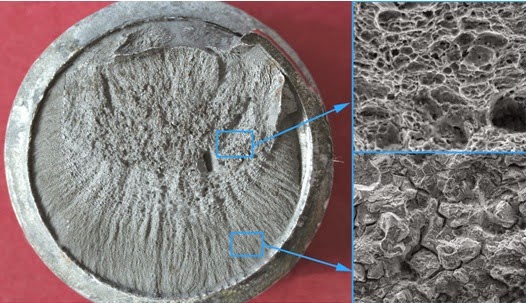Under the term Environmental Induced Cracking (EIC) a series of subcritical progression cracking processes are involved which result from the synergistic action of a mechanical stress combined with corrosion degradation under service conditions. Such phenomena are designated by the generic term Stress-Corrosion Cracking (SCC).
For many authors, Hydrogen Induced Cracking (HIC) is considered a special case of Stress-Corrosion Cracking, in which the progression of the crack is due to the embrittlement effect caused by the generation and absorption of hydrogen. From IK4-AZTERLAN it is preferred the interpretation of such failures as a particular case of hydrogen embrittlement, wherein the hydrogen source does not come from the manufacturing process, but is generated by a corrosive process in service conditions.
The Environmental Hydrogen Embryttlement (EHE) is experimentally a well-documented phenomenon, but it is not usually taken into consideration in the design stage (except perhaps in applications with cathodic protection or sacrificial anodes) and it is rarely included among the possible hypotheses when performing failure analysis of structural elements such as, for instance fastening elements. However, the use of high strength fastening elements with sacrificial coating (such as zinc) implies a potential risk for this type of embrittlement induced by the environment and should always be considered among the possible failure casuistry.
In zinc coated fastening elements is well-known the potential risk of hydrogen embrittlement caused by several causes intrinsic to the manufacturing process, such as the pickling bath prior to hot-dip galvanizing or the electroplating process itself. On the contrary, the behavior of this coating is rarely evaluated according to its anodic character. Zinc coatings are designed to work as sacrificial metal preventing the corrosion of the steel. If any deterioration or damage affecting its integrity is generated in these anodic coatings, leaving areas of the steel underneath exposed to the environment, a galvanic coupling between the coating and the exposed metal, which would turn this bare area into a cathodic position, preventing its corrosion. This capability that zinc has of protecting areas even bare of any coating is known as cathodic protection and is characteristic of such type of coatings.
However, the presence of discontinuities or cracks in the Zinc coating that allows the exposure of the bare metal to the electrolyte, allows the existence of galvanic cells between Zn and steel. All the surface of the fastener covered by the zinc works as the anode, releasing hydrogen atoms in cathodic positions; which further have a reduced area in relation to the extent of the anodic surface, which increases the emission intensity. The released hydrogen diffuses into the bare steel (cathode of the cell) triggering the localized abortion of diffusible atomic hydrogen at that position. Therefore the source of hydrogen would be the corrosion process of the coating layer itself.
The potential risk seems higher when taking into consideration the fact that it is precisely in the most stressed positions, such as fillets or thread roots where it is more likely to find small cracks in the coating. Thus, the hydrogenation phenomenon is focalized in the crack tip, which is also the point of maximum stress concentration, enabling localized embrittlement of the metal in the crack tip and makes possible a progressive advance of the crack by successive hydrogenation of the crack front, until the reduction of section reaches a critical value to trigger the collapse of the element.
The macroscopic appearance of the fracture surface of such kind of failures, in many cases, is similar to that of fatigue failure. With the particularity that if the distribution is of the axial load due to the applied tightening torque is relatively uniform in the section, several simultaneous radial progression fronts, nucleated around the outer edge of the section, are usually presented.
The texture of the progression area presents granular features, especially in the initial stages close to the periphery. This granular character gradually disappears inwards, where granular shapes are mixed with a characteristic features in the form of “ferns”. Often the last remnant section, not affected by the hydrogenation, exhibits very different fracture features, even ductile dimples and it is not rare that these two areas have very well defined limits, barely without transition, similar again to fatigue fractures.
It is well known that in any incidence related to hydrogen embittlement affecting a batch of “identical” components, produced in “identical” conditions, the failure takes place only in a small part of components apparently in a totally randomly way. When dealing with this kind of environmentally induced embrittlement phenomena, the random character of the failures is even greater, because it involves many more parameters or necessary conditions for the development of the failure.
A very important feature to evaluate this type of failures is the time elapsed from the installation until the fracture takes place. If this time is less than three days, it is more likely to be a failure due to embittlement by an intrinsic hydrogen source. On the contrary, if the failure occurs after several days or even months, it can be practically discarded the intrinsic source, and the hypothesis of an environmental hydrogenation should be strongly taken into consideration among the possibilities to be analyzed.
IK4-AZTERLAN has developed over the last years several research works related to environmental hydrogen embrittlement, whose incidence is much more severe than it seems to be or is recognized in the industry.
The diagnosis of these kinds of failures is a difficult task and somewhat unpopular, since in the end the responsibility of the failure is not clearly attributed to any of the parties involved (the production process of the component, the design of the tightened joint and the mounting procedure have been correctly performed but the assembly has failed and apparently, no one is responsible for it). Metallurgical knowledge and experience in fracture mechanics, along with the use of advanced analytical tools, helps in the identification of such phenomena.

In this fracture surface is evidenced the existence of an embrittlement phenomena. The initial stage of progression exhibits a mainly inter-granular mechanism, which implies a fragile behavior, while the final stage corresponds to a ductile fracture. No metallurgical factor can justify such big differences in the fracture mechanism.


